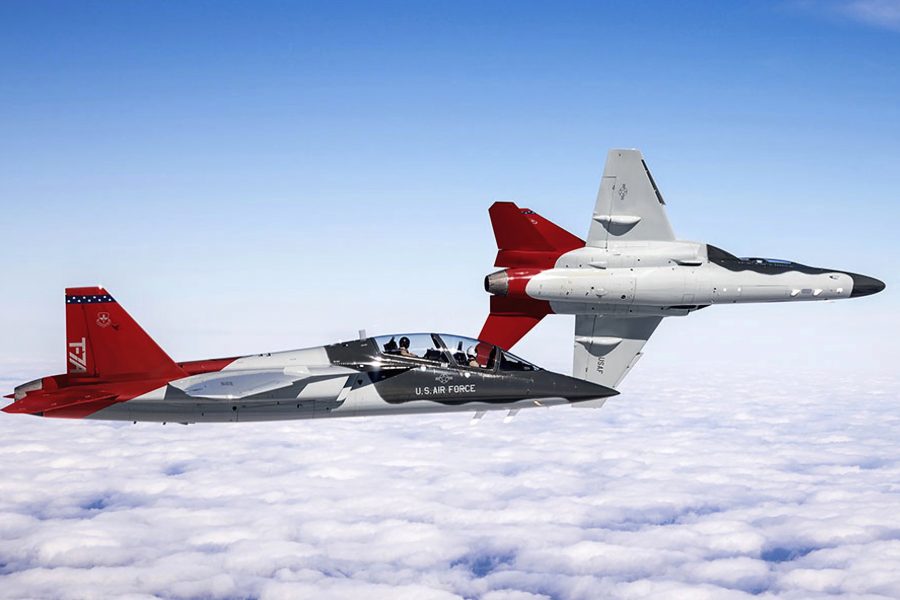The Boeing T-7 Red Hawk advanced trainer won’t be ready for a low-rate initial production decision until February 2025—six and a half years after Boeing won the initial contract in 2018.
The new date for the “Milestone C” initial production decision is as much as 14 months later than was anticipated as recently as late 2022, caused in part by concerns over the safety of ejection seats. Those and other issues are now or will soon be resolved, the Air Force said.
The first production aircraft will not be delivered until December 2025 at the earliest, USAF said. It is not clear how much the delays will push back initial operational capability (IOC), which was originally scheduled for 2024 and had more recently been promised for 2026.
Regardless, the ripple effect of T-7 delays could force the Air Force to invest in further life-extensions for its 60-year-old T-38 trainers, which the T-7 is supposed to replace. The Air Force continues to fund Pacer Classic III structural modifications for the aircraft, along with avionics upgrades, to the tune of $125.3 million in FY ’24.
The Air Force plans to buy at least 351 T-7A Red Hawks and 46 high-fidelity simulators. USAF’s new “Reforge” fighter pilot training plan could increase that total. Boeing’s contract provides for up to 475 aircraft.
The Air Force and Boeing “are confident improvements and recent testing are yielding a safe and effective escape system” for the T-7, a service spokesperson said.
Last year’s planning documents showed the service spending $321 million on T-7 production in fiscal 2024, but USAF zeroed-out T-7 production funding for fiscal 2024 in its recent budget request.
“Milestone C has moved to February 2025,” so procurement funding “for Low-Rate Initial Production is not needed in FY24,” she said. At Milestone C, the undersecretary of defense for acquisition and sustainment decides if a program has met its exit criteria from EMD and is ready for production.
Ejection Seat Concerns
A principal cause of delay were concerns noted across more than a dozen ejection seat tests. Air Force officials have said that tests showed Boeing’s escape system exhibiting unsafe deceleration at parachute opening, potentially causing pilots to suffer concussions as their visors tore off. Industry sources suggest, however, that USAF’s crash dummies were improperly instrumented, suggesting inaccurate results. The sources said USAF is revisiting some of those data.
Under the initial 2018 contract, Boeing was to have delivered the first five production aircraft in 2023. Most of those are now complete, but developmental flight testing has been held up by the seat issue and is now anticipated to start in September, the Air Force spokesperson said. Boeing said last week that it expected developmental testing to start “this summer.”
Boeing ran into problems with the seats last year when they didn’t function as expected with pilots at the smallest and lightest end of the range. The T-7 is the first USAF aircraft to be designed from the outset to accommodate pilots in a wide variety of physical sizes. Ejection systems on previous trainers and fighter aircraft could accommodate only a narrow range of physiques and excluded too many potential student pilots, particularly small women.
Air Force acquisition executive Andrew Hunter said in March budget testimony that recent sled tests with the seats have given confidence that the ejection problems are on the mend.
“Minor changes to seat logic” have “already reduced system risk and increased pilot safety,” the spokesperson explained. Additionally, “the USAF and Boeing are studying the ejection seat performance throughout 2023 to identify additional enhancements, and Boeing will use the results of testing to inform changes needed to qualify the seat as safe for production.”
Supply chain issues have also contributed to T-7 delays, the Air Force said.
“Prior to the FY ’23 President’s Budget,” the Air Force and Boeing “recognized schedule impact to the T-7A ‘Red Hawk’ program partially attributable to developmental discovery and the COVID-19 global pandemic,” the USAF spokesperson said.
In June 2022, USAF and Boeing “began a schedule re-baseline effort to assess the collective impacts of all schedule delays to date, to include…ground [testing], pre-flight testing and hardware qualification challenges; contractor inability to rapidly correct deficiencies; subcontractor initial design delays; three aerodynamic instability discoveries; escape system qualification delays; and supplier critical parts shortages,” she explained.
After an “exhaustive” schedule risk assessment, “the T-7 office program office recommended a new [Milestone C] date of February 2025 and is awaiting final coordination of this change,” the spokesperson said.
The Air Force does not plan to accelerate testing to gain back lost time. The Air Force and Boeing “do not believe the delays can be overcome by more aggressive flight test,” the spokesperson said. The planned flight test schedule “is already success-based and aggressive.”
Boeing has been flying its first two T-7s—”T1” and “T2,” which the Air Force refers to as “production relevant”—at the company’s St. Louis, Mo., facilities, but Air Force pilots are not permitted to fly the pre-EMD jets for testing purposes until the seat and other issues have been resolved.
The first three engineering and manufacturing development (EMD) examples of the T-7 are complete and two further aircraft are in the final stages of construction, USAF said. These five jets “will be enough for flight testing.”
Air Force leaders have pointed to the T-7A as a pathfinder for how major systems will be bought in the future. Boeing and its partner Saab of Sweden managed to go from digital design of the T-7 prototypes to first flight in three years, and the mating of fuselage and wing sections was done with no shimming. The $9 billion T-7 contract was deemed to be about $10 billion below the Air Force’s estimates for the program, and far below Boeing’s competitors in the T-X contest. Company officials said the digital approach made their bid realistic and not a low-ball.
